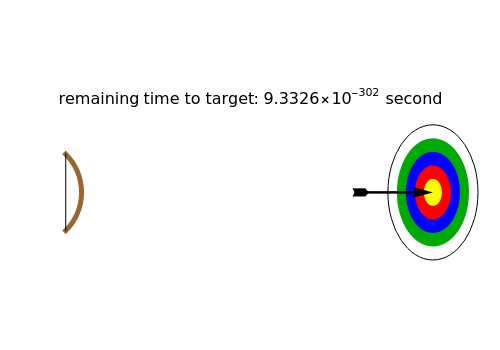Zeno's Arrow Paradox and an Infinite Series
Zeno's Arrow Paradox and an Infinite Series
The Greek philosopher Zeno of Elea (ca. 490–430 BCE) is generally believed to have devised a group of paradoxes pertaining to motion over a finite distance during a finite interval of time. By Zeno's argument, an arrow shot at a target must first cover half the distance to the target, then half of the remaining distance, and so on. But this requires an infinite number of steps, so the arrow will never reach the target!
The distance traveled by the arrow toward the target can be represented by an infinite series ++++…=. It is now understood, of course, that an infinite series can converge to a finite limit. In the present case, =1. Let us assume that in real life, the arrow hits the target 1 second after release. The time remaining after steps, each halving the remaining distance, is then shown in the graphic.
1
2
1
4
1
8
1
16
∞
∑
k=1
1
k
2
∞
∑
k=1
1
k
2
n
Details
Details
It is tempting to conclude that Zeno’s paradoxes were resolved after the introduction of the infinitesimal calculus and the understanding of convergent infinite series. In fact, the early twentieth-century philosopher C. S. Peirce claimed that "this ridiculous little catch presents no difficulty at all to a mind adequately trained in mathematics and logic."
However, some philosophical fine points are still under discussion[1], pertaining mainly to whether space and time are infinitely divisible, and to the exact meanings of a point in space and an instant in time. Recall that matter turned out not to be infinitely divisible.
References
References
[1] N. Huggett. "Zeno's Paradoxes." The Stanford Encyclopedia of Philosophy. (Dec 11, 2017) plato.stanford.edu/entries/paradox-zeno.
External Links
External Links
Permanent Citation
Permanent Citation
S. M. Blinder
"Zeno's Arrow Paradox and an Infinite Series"
http://demonstrations.wolfram.com/ZenosArrowParadoxAndAnInfiniteSeries/
Wolfram Demonstrations Project
Published: December 12, 2017
